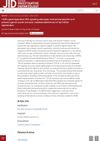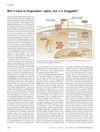Search
forLearn
3 / 3 resultslearn Osteopontin
signaling protein that, when suppressed, may grow hair by reducing inflammation and stem cell loss
learn Beta Polypeptide
Research
5 / 1000+ results
research Ligand-Dependent Wnt Signaling Attenuates Mechanotransduction and Protects Against Wound Occlusion-Mediated Abolishment of Hair Follicle Regeneration
Covering a wound can stop hair growth by promoting scarring, but boosting a process called Wnt signaling can help hair grow back even when the wound is covered.
research Ligand-Dependent Wnt Signaling Attenuates Mechanotransduction and Protects Against Wound Occlusion-Mediated Abolishment of Hair Follicle Regeneration
research Wnt Signaling Drives Hair Follicle Regeneration in Wounds by Attenuating Mechanotransduction in the Epidermis
Wnt signaling helps regenerate hair follicles in wounds by reducing skin cell sensitivity to mechanical stress.

research Wnt Is Back in Drugmakers' Sights, but Is It Druggable?
Drugmakers are optimistic about targeting the Wnt pathway for new treatments despite past challenges.
research The Vitamin D Receptor Is a Wnt Effector That Controls Hair Follicle Differentiation and Specifies Tumor Type in Adult Epidermis
Vitamin D receptor helps control hair growth and could be used to treat certain skin tumors.
Community Join
5 / 22 results
community Compressed part of research of theory of androgenic/anabolitic balance. AGA h-responders analytic. Theory of physio-metabolitic method of anti AGA treatment
The treatment for androgenetic alopecia involves using finasteride and minoxidil with intense exercise and cold exposure to boost metabolism and reduce androgenic effects, potentially leading to hair regrowth. This approach may activate biological pathways for improved hair and overall health.
community The Real Cause Of Androgenetic Alopecia
Androgenetic alopecia is caused by DHT affecting hair growth. Finasteride and minoxidil are used to manage hair loss by blocking DHT and promoting hair growth.
community Study: There is 70x Higher Unconjugated DHT in Feces Compared To Blood Levels in Young Adults - Gut Microbiota Manages DHT Recycling and Metabolism
Gut microbiota significantly influences androgen metabolism, impacting hair loss treatments like finasteride. Probiotics, dietary changes, and fecal microbiota transplants may help manage DHT levels and improve hair health.
community Bile Acid-Mediated DHT Dysregulation Hypothesis
Elevated bile acids can inhibit the enzyme AKR1C2, leading to increased DHT levels, which may accelerate hair loss in those predisposed to androgenetic alopecia. Treatments mentioned include topical minoxidil and finasteride.
community Finasteride, dutasteride, and oral min- My experience
User took Fin for 3 years, Dut for 7 months, and oral Min for 2 months without side effects. Fin stopped hair loss for 2 years, Dut maintained hair, and oral Min regrew thinning hair.